Structuring Your CUNY Commons Course for Distance Learning: Creating an OER with Thomas Miller!
Hello, members of the CUNYverse!
Today, in continuation of our series on designing courses for distance learning, we are going to be looking at our next Commons course site and our first site that doubles as an open educational resource (OER) on the Commons! This site/resource was created by Dr. Tom Miller, an Adjunct Associate Professor of the Department of Anthropology and Archaeology at Brooklyn College! His academic interests include sound, music, media, shamanism, museums, and the history of anthropology. He received his doctorate from Columbia University and has curated museum exhibitions and multimedia installations in the U.S. and Europe. Dr. Miller previously taught at NYU, Rutgers-Newark, Pratt Institute and CUNY Guttman Community College. During the Spring 2020 semester, he was teaching Comparative Studies in Culture and Transformation (ANTH 1105) at Brooklyn College when CUNY began transitioning to distance learning.
*For those who haven’t seen the previous posts from this series: InCommon has been working on is reaching out to and interviewing instructors who recently remodeled their courses for distance learning on the CUNY Academic Commons. In response to CUNY and its large population of faculty preparing for their remaining summer courses (and possibly fall courses) to be online, I thought it might be helpful to receive insight from instructors who structured their CUNY Commons course site particularly well. In these pieces, you will read the interview conducted with the faculty member, and I will add images, links, etc. throughout the interviews for references and ease of exploration.
CUNY Commons: Before we get into the course itself, why the CUNY Academic Commons? What made you decide to teach on the Commons?
Miller: Teaching at a number of colleges, I’ve always brought Library faculty and staff into my courses as collaborators in developing and managing project-based assignments. For Anthropology of Sex (ANTH 2210) in Fall 2019, senior library liaisons helped my students write, design, and publish feminist zines that became part of the Brooklyn College Library’s permanent collection. ANTH 1105 is an introductory course offered by the department that presents two distinct cultural groups from different parts of the world in a comparative framework, based around each individual professor’s specific area of research. Students gain access to primary field materials, while professors receive valuable feedback on their ideas. When the Library invited me to collaborate on an Open Educational Resource (OER) site for ANTH 1105, I thought it could be a good way to create a specific, media-rich online environment. The opportunity to build a dedicated resource bank seemed like a good fit for such a customized approach. For their part, the Library was interested in developing prototype models for providing students full online access to a wide range of textbook-free, cost-free, rights-cleared content.
CUNY Commons: Did your course have a site before the transition to distance learning? If yes, how did you introduce it, what modifications were made to accommodate distance learning?

Miller: When we had to suddenly move everything online mid-semester we had already prepared the tools to create a distance learning experience that not only worked but was in some ways enhanced by new possibilities. The OER was in use and still being added to when the transition happened. After the shutdown, I tried to keep things as technologically simple as possible, which in our case meant relying on Blackboard as the central forum. The OER became an important element in a mediascape that included Blackboard discussion boards, course documents, announcements, audio lectures on SoundCloud, livestream broadcasts, museum archives, and more. Documenting the pandemic quarantine experience itself became a big part of it. We started out in January 2020 in a world that no longer exists, and we still don’t know what kind of world will greet us when we have finally, fully emerged from our cocoons.
After life itself moved indoors and online in March 2020, students wrote postcards, listened to, indexed, cataloged, and logged streaming radio from Africa including news, public affairs, call-in programs, music, local advertisements, and frequent public service announcements about coronavirus. For their final project, they exchanged voice-recorded messages or “audio letters” with their youthful African counterparts in the Zambezi valley, a contribution to a permanent and growing public online archive. Listening to this collaborative documentation in sonic anthropology of a unique moment in world history is a powerful experience as one hears their shared worries, fears, and hopes. We lost the human connection once we could no longer meet in person or have normal social interactions, as did students and others all over the world; yet through online call-and-response students not only read and talked about people and cultures across the ocean, they established personal relationships with them.
CUNY Commons: Do you mind quickly explaining what your course is about and what the learning goals are?
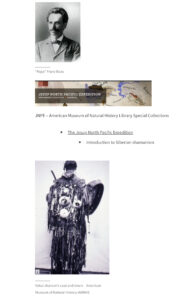
Miller: Because each Anthropology professor specializes in a different part of the world, no two sections of ANTH 1105 are alike and there is no standard textbook or syllabus. I specialize in the circumpolar regions of Siberia and the far north; I also have a museum background and ongoing research projects in African ethnology. My pedagogical goals for this 100-level introduction included training students in close reading, looking, and listening.
Weekly assignments included cataloging and describing artifacts, photographs, and sound recordings from online collections including the American Museum of Natural History, the Brooklyn Museum, the Macaulay Library at Cornell Ornithology Lab, and the Zambia National Broadcasting Corporation. On another level, I want them to challenge habitual assumptions and develop ethnographic imaginations by trying to fathom the lives of others. With their final project, students moved from reading and talking about people in distant places to communicating directly with them across borders.
CUNY Commons: Your site is jam-packed with visuals and multimedia! Excellent use of the Customizr theme! How does using media on the site relate back to the goals of the course?
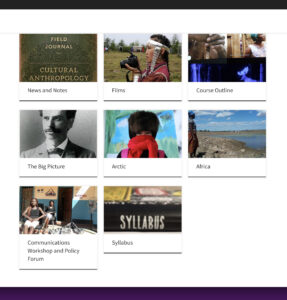
Miller: Many techniques were developed on the fly. Adaptability came to the forefront. Unfortunately, I had to make deep cuts in the second half of the syllabus, due to lost time from the shutdown and the need to reorganize and streamline content. Media was an integral part of the design, to begin with, but without classroom meetings, it became more important than ever. The audio recordings made by the students are also media documents.
CUNY Commons: I noticed there’s not a place for student posts, in what ways do they submit their assignments? What was your thinking behind this?
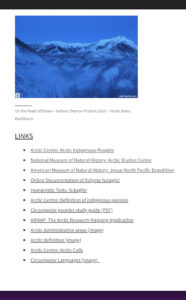
Miller: I worked with Colin McDonald (OER Developer at Brooklyn College as well as the CUNY Academic Commons’ Project Manager) in the Library to create a central repository for course materials that would be user-friendly, practical, aesthetically designed, and adjustable. Day-to-day announcements, postings, assignments, and submissions were handled via Blackboard. With the OER we were able to give students full-text online access to unusual materials including field notes, hard-to-find ethnographies, and museum archives. We got permission to excerpt passages from a newly published historical novel, The Old Drift by Zambian author Namwali Serpell. There was more content planned for the OER, but because of the lost weeks during the shutdown, quite a few items had to be dropped.
In the sudden transition to distance learning mid-semester, the proliferation of emails and written communication was voluminous, almost overwhelming at times with grading, workloads, formats, deadlines, schedules, and exams all in flux. In the end, the combined work of 75 students in two sections generated hundreds of pages of text and more than 150 audio recordings. In this crowded arena, maintaining the OER as a user-friendly, streamlined, dedicated resource bank where students could quickly and easily find the texts, media, and other resources they needed to complete their assignments and exams really helped them cut through the mass of information that accumulated in email, Blackboard, and other platforms.
CUNY Commons: Do you mind giving us some brief pedagogical insight into the structuring of the class site?
Miller: We had to decide early on: what was it going to be – a syllabus? A resource bank? A blog? Resources were limited. For me as the professor, given the project-based teaching style of this particular course design, flexibility and the ability to make real-time updates were crucial, so they were already built-in when the unexpected transition to distance learning began. During the transition, I reorganized the course materials and syllabus from weekly lesson plans to a series of topic unit modules with flexible due dates.
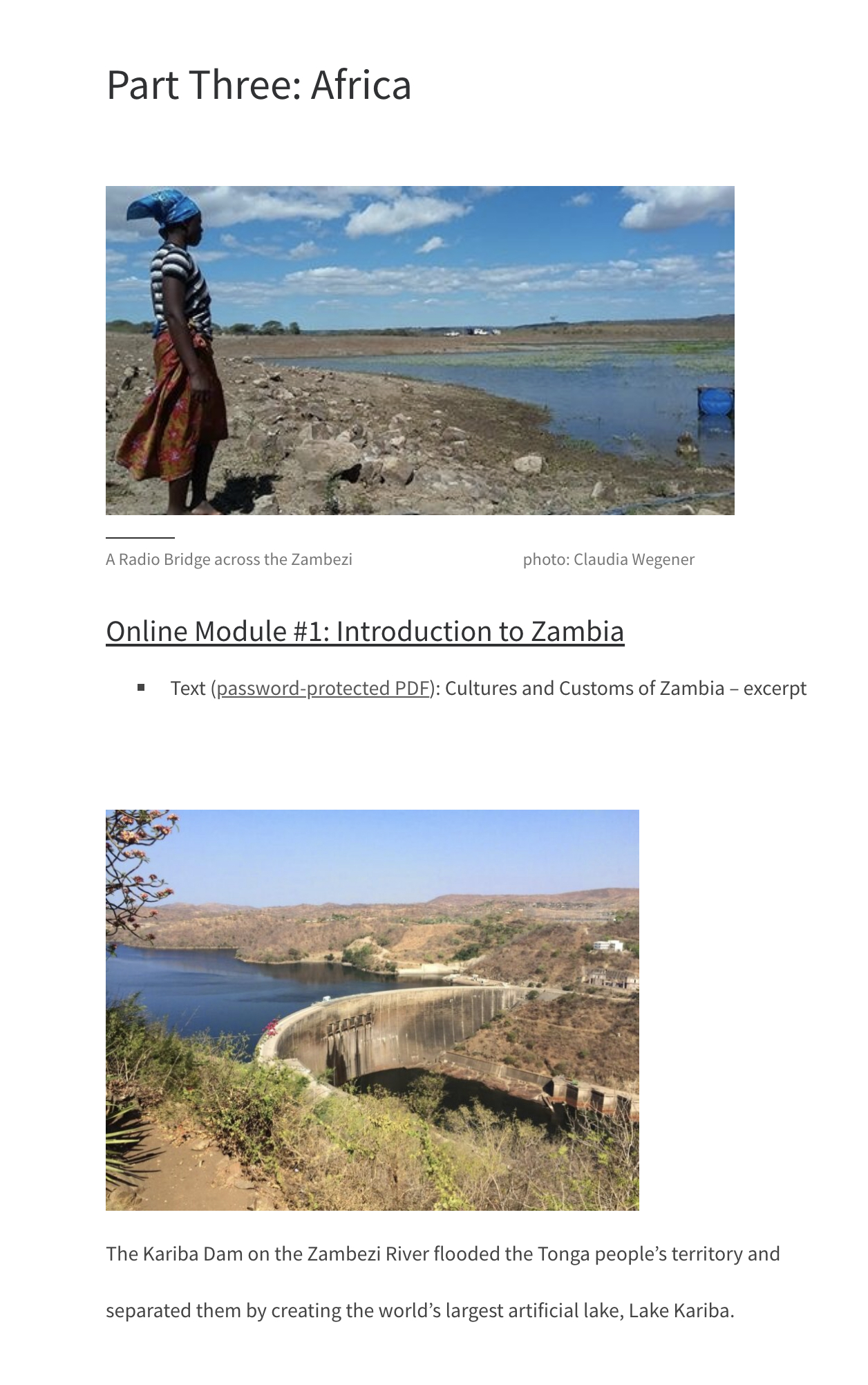
Connecting CUNY students to a sonic anthropology project I was involved with was another way of bringing primary ethnographic research into the class and fulfilling the methodological goals of ANTH 1105. For their online final project from pandemic quarantine, students recorded personal greetings and messages as “audio letters” to young radio producers in Zambia and Zimbabwe whose work they were listening to and studying, and they invited their African counterparts to respond in kind. In order to have a truly collaborative exchange it was important to have an international partnership, so let me give you a bit of background on the project. Radio is the most important medium for news, information, talk, and cultural exchange in many rural African areas where internet access is scarce or unavailable. Zongwe FM is a small, independent community radio station in Zambia, located across the vast Lake Kariba from Zimbabwe. Tonga people were forcibly resettled in the area in the late 1950s when the colonial construction of the Kariba Dam flooded the Zambezi River valley, turning their former lands into the world’s largest man-made lake. While the dam provides hydroelectric power to much of the region, the two halves of their community have been separated by the artificial Lake Kariba and the border between the two countries for more than 60 years. Zubo Trust is an organization working with women in Binga District, Zimbabwe for self-empowerment in income-generating projects utilizing the natural resources of this remote area, such as fishing. With the women of the Zongwe FM staff and Claudia Wegener of radio continental drift, they produced radio programs documenting their work and also interviewed their elders, mothers, and grandmothers on Tonga culture, tradition, and history. The organizers then invited people around the world to listen to these recordings on the Internet Archive, respond, and remix, which is where my previous involvement and our class project comes in.
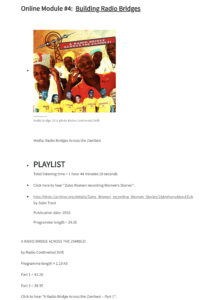
Brooklyn College students listened to curated playlists from the archives of Zubo Trust and Zongwe FM, then recorded personal messages from pandemic lockdown responding to their fellow students in Africa, inviting them to reply in turn. With the expectation that these recordings would eventually become part of a public archive and possibly be used in radio broadcasts and remixes, everyone was given the option of either participating or opting out and completing an alternate final assignment. A handful opted out; most of the students chose to participate, volunteered to make their contributions public under a Creative Commons license, and signed up for a mailing list to receive future project updates. Many of them were deeply moved, inspired, and excited to be involved as they asked questions about Tonga women, fishing, radio, the aging Kariba Dam, and many other topics. Some even wrote songs or read poetry, describing their view of the pandemic crisis while at the same time finding new hope in the stories told by Tonga women. They were encouraged to address their remarks person-to-person, document their experiences of the lockdown in New York, and inquire about the state of coronavirus and quarantine in Zambia and Zimbabwe.
Audio replies from their African counterparts, many of whom are students themselves, are still coming in. They have sent warm greetings and expressed surprise, happiness, and encouragement at the concerns of our students and the opening of this window of global communication in a time of mutual isolation. Even though the semester has ended, many of the Brooklyn College students (including some graduating seniors) intend to continue voluntarily participating in the ongoing exchange. A mixed playlist of selections from these conversations can be heard at the Internet Archive under the title “Audio Letters from Lockdown NYC: To the Zambezi Valley, with Love,” where we are continuing to publicly post audio letters from both sides for all to hear and use under a Creative Commons license (see URLs below). By ensuring that the linked OER site remains accessible via the CUNY Academic Commons, we offer a powerful resource for more students, faculty, and anyone else to find information, ideas, and each other.
CUNY Commons: Any tips for instructors who would like to make a Commons class site for distance learning in the Summer session and potentially the Fall?
Miller: Be prepared to adjust to circumstances; course plans, like life, are subject to change. Given the ongoing uncertainty of the pandemic situation, a big challenge in adapting onsite courses for online or hybrid learning is to thread the needle between flexibility and structure. Having a dedicated online space can help provide stability, adaptability, and clarity, a balancing act which stressed-out students will appreciate. I think it’s important for the faculty member to share the site Admin role with a librarian. In this case, the ability to update the site as needed was crucial for me as the professor; this meant I had to have access to edit the site directly since the busy schedules of Library staff often keep them from being able to implement adjustments quickly and in real-time. Collaboration between professors and library colleagues in designing aesthetic and functional WordPress sites can open up a lot of creative possibilities to increase access, customize course materials, and enhance learning experiences. Using the Commons can inspire others to create new kinds of innovative online courses. As my students’ heartfelt voice recordings and the strong positive response they have received from across the Atlantic have shown, distance learning can also be long-distance communication, bringing far-away voices into the conversational mix with those who are nearby. The fact that this work is publicly accessible via the CUNY Academic Commons ties people and communities together and makes new connections possible.
Prof. Tom Miller, thank you for your participation in this series! Your dedication to broadening the experiences of students internationally is inspiring, and I hope this piece encourages more instructors to think outside the box in terms of ways to mold the Commons for such innovative practices. In addition, highlighting ways to bring culture and the curation of music into our online learning environments is simply astounding! Also, special thanks to Claudia Wegener of radio continental drift, without whom this work would not have been possible! Our blog will be returning with another course feature very soon, so keep an eye out! We here at the Commons are here to support you as we finish out our Summer semesters and prepare for the Fall 2020 term!
Best,
Anthony
*Are you an instructor who teaches using the CUNY Academic Commons? Let us know! We’d love to check out your course and feature you on the InCommon blog! Send us a message or tweet us @cunycommons!
Additional Links
Link to Open Educational Resource (OER) for Dr. Tom Miller’s Spring 2020 ANTH 1105 at Brooklyn College: https://anth1105miller.commons.gc.cuny.edu/
Audio stream/download playlist of remixed tracks from the archive created by students at Brooklyn College and in Africa: https://archive.org/details/BuildingRadioBridges_2020/42+Lockdown+Song+(Echo)+-+Antenna+Garden+mix+2.mp3
Sample audio letters from Brooklyn College students to Zongwe FM DJs (Zambia) and the women of Zubo Trust (Zimbabwe): https://archive.org/details/Building_Radio_Bridges_Zim_Zam_NY
Responses from Zongwe FM DJs (Zambia) and the women of Zubo Trust (Zimbabwe) to Brooklyn College students: https://archive.org/details/building_radio_bridges_zim_zam_ny_202006


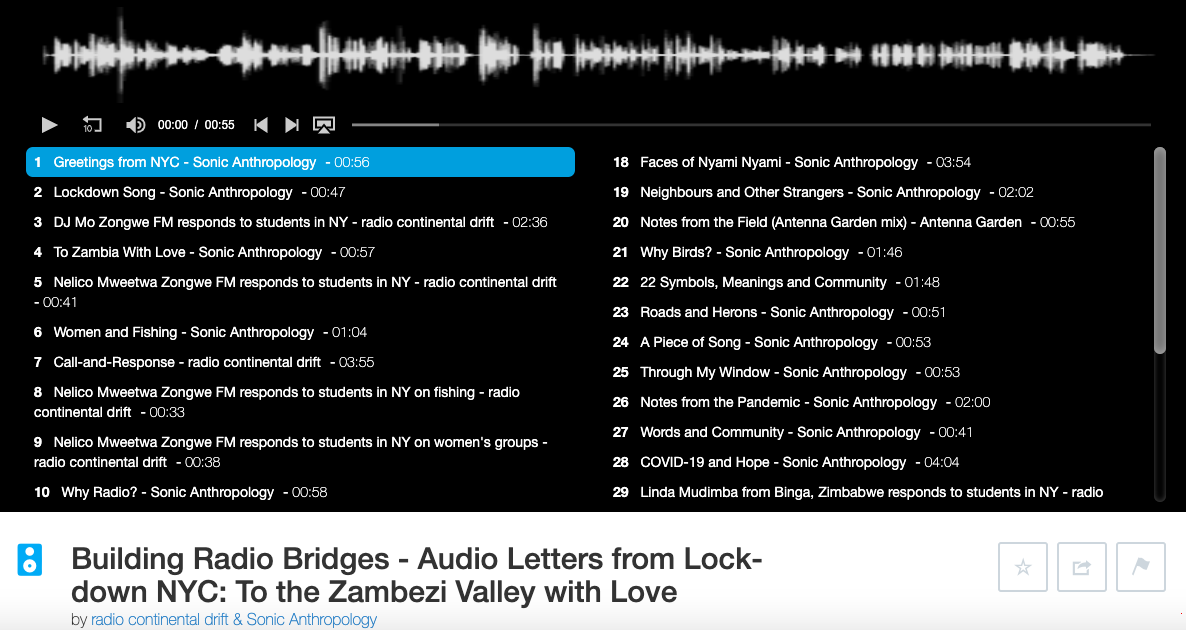



Remote communication meets distance learning leading to a long-distance co-production. We are exited to be participating in an astounding journey under global lockdown conditions with Tom Miller and his students in NYC and members of Zubo Trust and Zongwe FM in the Zambezi Valley. Twalumba loko kutuswiilila, Thank you for listening. Claudia Wegener/ radio continental drift in Germany